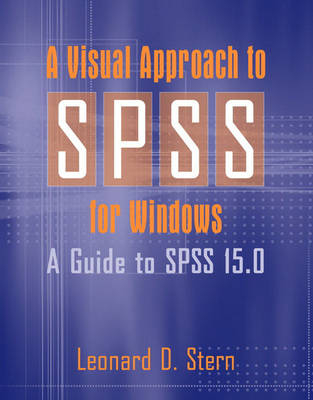
A Visual Approach to SPSS for Windows
Pearson (Verlag)
978-0-205-54695-4 (ISBN)
- Titel ist leider vergriffen;
keine Neuauflage - Artikel merken
PREFACE
CHAPTER 1: THE BASICS
Starting SPSS
Exiting SPSS
Using The Tutorial For More Information
Exercise For Chapter 1
CHAPTER 2: ENTERING AND SAVING DATA
Entering Data Using The Keyboard
Entering Data From An Spss Data File
Entering Data From An Excel File
Entering Data From A Text (.Txt) Or Data (.Dat) File
Saving Data
Exercises For Chapter 2 C
HAPTER 3: MODIFYING DATA IN THE DATA EDITOR
Changing The Content Of A Data Cell
Inserting A Variable
Removing A Variable
Inserting A Case
Removing A Case
Exercises For Chapter 3
CHAPTER 4: DEFINING VARIABLES’ PROPERTIES
Naming Variables And Declaring Their Types
Labeling Variables
Assigning Value Labels For Categorical Numeric Variables
Adjusting Column Width And Number Of Columns In Data View
Exercises For Chapter 4
CHAPTER 5: PRINTING DATA FROM THE SPSS DATA EDITOR
Printing The Entire File
Printing A Portion Of The File
Exercises For Chapter 5
CHAPTER 6: THE SPSS VIEWER
Producing And Working With Output
Inserting Text In The Viewer
Printing The Output Visible In The Contents Pane
Exercises For Chapter 6
CHAPTER 7: DATA TRANSFORMATION AND CASE SELECTION
Recoding Data
Using Visual Binning To Convert Scale To Categorical
Variables
Using Compute To Create New Variables
Selecting A Subset Of Cases For Analysis
Exercises For Chapter 7
CHAPTER 8: THE FREQUENCIES PROCEDURE
Information Obtained From A Frequency Distribution
Key Properties Of Distributions
Using The Frequencies Procedure
Interpreting The Output
Options For The Frequencies Procedure
Graphing Distributions
Exercises For Chapter 8
CHAPTER 9: OTHER PROCEDURES FOR OBTAINING DESCRIPTIVE
MEASURES: DESCRIPTIVES, EXPLORE, MEANS
Descriptives
Explore
Means
Summary Of Procedures Providing Descriptive Measures
Exercises For Chapter 9
CHAPTER 10: BIVARIATE CORRELATION AND REGRESSION
Overview
Requesting A Scatterplot
Requesting A Regression Analysis
Inspecting The Output
Dealing With Data That Violate Underlying Assumptions
Finding All Possible R Values For Pairs Of Variables In A Data
Set
Exercises For Chapter 10
CHAPTER 11: MULTIPLE REGRESSION AND CORRELATION
Overview
Requesting A Multiple Regression Analysis
Interpreting The Output
Hierarchical Multiple Regression
Exploring For Optimal Independent Variables
Exercises For Chapter 11
CHAPTER 12: CHI-SQUARE TESTS OF INDEPENDENCE AND GOODNESS- OF-FIT
Chi-Square Test Of Independence
Chi-Square Goodness-Of-Fit Test
Exercises For Chapter 12
CHAPTER 13: ONE AND TWO SAMPLE T-TESTS
Overview
The Single Sample T-Test
T-Test For Two Independent Samples
T-Test For Paired Samples
Exercises For Chapter 13
CHAPTER 14: ONE-WAY ANALYSIS OF VARIANCE
Introduction
Preparing Data For The Analysis
Requesting A One-Way Anova
Interpreting The Output
Requesting Planned Comparisons
Corrections For Multiple Tests Of Data And Post-Hoc Tests
Exercises For Chapter 14
CHAPTER 15: TWO-WAY AND HIGHER ORDER ANALYSES OF VARIANCE
Overview
Three-Way Anovas
Exercises For Chapter 15
CHAPTER 16: WITHIN-SUBJECTS ANOVAS
One-Way Within-Subjects Design
Two-Way Within-Subjects Designs
Combining One Within- And One Between-Subjects Factor: The
Mixed Two-Factor Design
Exercises For Chapter 16
CHAPTER 17: NONPARAMETRIC OR DISTRIBUTION FREE TESTS
Overview
Tests Involving Single Samples
Tests Involving Two Samples
Exercises For Chapter 17
CHAPTER 18: EXPLORATORY FACTOR ANALYSIS
Introduction
Steps In Performing An Exploratory Factor Analysis
Deriving Principal Components
Underlying Assumptions
Preparing Data For The Analysis
Requesting An Exploratory Factor Analysis
Interpreting The Output
Exercises For Chapter 18
CHAPTER 19: DISCRIMINANT ANALYSIS
Introduction
An Example
Outcome Of An Analysis
Underlying Assumptions
Requesting A Discriminant Analysis
Interpreting The Output
Another Example
Exercises For Chapter 19
APPENDIX A: Using The Chart Editor To Insert A Reference Line And Data Labels
APPENDIX B: Using The Chart Editor To Add A Title To The X-Axis
REFERENCES
INDEX
| Erscheint lt. Verlag | 4.9.2007 |
|---|---|
| Sprache | englisch |
| Maße | 216 x 276 mm |
| Gewicht | 880 g |
| Themenwelt | Mathematik / Informatik ► Mathematik ► Computerprogramme / Computeralgebra |
| ISBN-10 | 0-205-54695-1 / 0205546951 |
| ISBN-13 | 978-0-205-54695-4 / 9780205546954 |
| Zustand | Neuware |
| Informationen gemäß Produktsicherheitsverordnung (GPSR) | |
| Haben Sie eine Frage zum Produkt? |
aus dem Bereich


